Working with Carousel in WPF Carousel
This section explains different UI customization and common features available in Carousel control.
Populating items using CarouselItem
You can add the carousel items inside the control using the CarouselItem property.
<syncfusion:Carousel x:Name="carousel"
Height="700" Width="500">
<syncfusion:CarouselItem>
<syncfusion:CarouselItem.Content>
<Viewbox Height="100" Width="100">
<Image Source="Images/Buchanan.png"/>
</Viewbox>
</syncfusion:CarouselItem.Content>
</syncfusion:CarouselItem>
<syncfusion:CarouselItem>
<syncfusion:CarouselItem.Content>
<Viewbox Height="100" Width="100">
<Image Source="Images/Callahan.png"/>
</Viewbox>
</syncfusion:CarouselItem.Content>
</syncfusion:CarouselItem>
<syncfusion:CarouselItem>
<syncfusion:CarouselItem.Content>
<Viewbox Height="100" Width="100">
<Image Source="Images/Davolio-1.png"/>
</Viewbox>
</syncfusion:CarouselItem.Content>
</syncfusion:CarouselItem>
<syncfusion:CarouselItem>
<syncfusion:CarouselItem.Content>
<Viewbox Height="100" Width="100">
<Image Source="Images/Callahan.png"/>
</Viewbox>
</syncfusion:CarouselItem.Content>
</syncfusion:CarouselItem>
<syncfusion:CarouselItem>
<syncfusion:CarouselItem.Content>
<Viewbox Height="100" Width="100">
<Image Source="Images/dodsworth.png"/>
</Viewbox>
</syncfusion:CarouselItem.Content>
</syncfusion:CarouselItem>
<syncfusion:CarouselItem>
<syncfusion:CarouselItem.Content>
<Viewbox Height="100" Width="100">
<Image Source="Images/Fuller.png"/>
</Viewbox>
</syncfusion:CarouselItem.Content>
</syncfusion:CarouselItem>
<syncfusion:CarouselItem>
<syncfusion:CarouselItem.Content>
<Viewbox Height="100" Width="100">
<Image Source="Images/King.png"/>
</Viewbox>
</syncfusion:CarouselItem.Content>
</syncfusion:CarouselItem>
<syncfusion:CarouselItem>
<syncfusion:CarouselItem.Content>
<Viewbox Height="100" Width="100">
<Image Source="Images/Leverling.png"/>
</Viewbox>
</syncfusion:CarouselItem.Content>
</syncfusion:CarouselItem>
</syncfusion:Carousel>Carousel carousel = new Carousel()
{
Width=700,
Height = 500
};
Image image = new Image();
Image image1 = new Image();
Image image2 = new Image();
Image image3 = new Image();
Image image4 = new Image();
Image image5 = new Image();
Image image6 = new Image();
Image image7 = new Image();
BitmapImage bitimg1 = new BitmapImage(new Uri("/Sample;component/Images/1.png", UriKind.RelativeOrAbsolute));
BitmapImage bitimg2 = new BitmapImage(new Uri("/Sample;component/Images/2.png", UriKind.RelativeOrAbsolute));
BitmapImage bitimg3 = new BitmapImage(new Uri("/Sample;component/Images/3.png", UriKind.RelativeOrAbsolute));
BitmapImage bitimg4 = new BitmapImage(new Uri("/Sample;component/Images/4.png", UriKind.RelativeOrAbsolute));
BitmapImage bitimg5 = new BitmapImage(new Uri("/Sample;component/Images/5.png", UriKind.RelativeOrAbsolute));
BitmapImage bitimg6 = new BitmapImage(new Uri("/Sample;component/Images/6.png", UriKind.RelativeOrAbsolute));
BitmapImage bitimg7 = new BitmapImage(new Uri("/Sample;component/Images/7.png", UriKind.RelativeOrAbsolute));
BitmapImage bitimg8 = new BitmapImage(new Uri("/Sample;component/Images/8.png", UriKind.RelativeOrAbsolute));
image.Source = bitimg1 as ImageSource;
image1.Source = bitimg2 as ImageSource;
image2.Source = bitimg3 as ImageSource;
image3.Source = bitimg4 as ImageSource;
image4.Source = bitimg5 as ImageSource;
image5.Source = bitimg6 as ImageSource;
image6.Source = bitimg7 as ImageSource;
image7.Source = bitimg8 as ImageSource;
carousel.Items.Add(new CarouselItem() { Content = new Viewbox(){ Child = image }});
carousel.Items.Add(new CarouselItem() { Content = new Viewbox(){ Child = image1 }});
carousel.Items.Add(new CarouselItem() { Content = new Viewbox(){ Child = image2 }});
carousel.Items.Add(new CarouselItem() { Content = new Viewbox(){ Child = image3 }});
carousel.Items.Add(new CarouselItem() { Content = new Viewbox(){ Child = image4 }});
carousel.Items.Add(new CarouselItem() { Content = new Viewbox(){ Child = image5 }});
carousel.Items.Add(new CarouselItem() { Content = new Viewbox(){ Child = image6 }});
carousel.Items.Add(new CarouselItem() { Content = new Viewbox(){ Child = image7 }});
NOTE
Populating items using collection binding
You can populate items to the Carousel control by setting the collection value to the ItemsSource property.
//Model.cs
public class CarouselModel {
public string Header { get; set; }
}
//ViewModel.cs
public class ViewModel {
private ObservableCollection<CarouselModel> collection;
public ObservableCollection<CarouselModel> HeaderCollection
{
get {
return collection;
}
set {
collection = value;
}
}
public ViewModel() {
HeaderCollection = new ObservableCollection<CarouselModel>();
HeaderCollection.Add(new CarouselModel() { Header = "Buchanan" });
HeaderCollection.Add(new CarouselModel() { Header = "Callahan" });
HeaderCollection.Add(new CarouselModel() { Header = "Davolio" });
HeaderCollection.Add(new CarouselModel() { Header = "Dodsworth" });
HeaderCollection.Add(new CarouselModel() { Header = "Fuller" });
HeaderCollection.Add(new CarouselModel() { Header = "King" });
HeaderCollection.Add(new CarouselModel() { Header = "Leverling" });
HeaderCollection.Add(new CarouselModel() { Header = "Suyama" });
}
}<Window.DataContext>
<local:ViewModel/>
</Window.DataContext>
<Grid>
<syncfusion:Carousel Name="Carousel"
ItemsSource="{Binding HeaderCollection}">
<syncfusion:Carousel.ItemTemplate>
<DataTemplate>
<Border Height="50"
Width="100"
BorderBrush="Purple"
BorderThickness="5"
Background="LightBlue">
<TextBlock HorizontalAlignment="Center"
VerticalAlignment="Center"
Text="{Binding Header}"/>
</Border>
</DataTemplate>
</syncfusion:Carousel.ItemTemplate>
</syncfusion:Carousel>
</Grid>
NOTE
Custom view path
By default, carousel items are arranged in a circular path. If you want to customize the view path of carousel item, use the VisualMode property value as CustomPath. The default value of VisualMode property is Standard.
<syncfusion:Carousel VisualMode="CustomPath"
Name="carousel"/>carousel.VisualMode = VisualMode.CustomPath;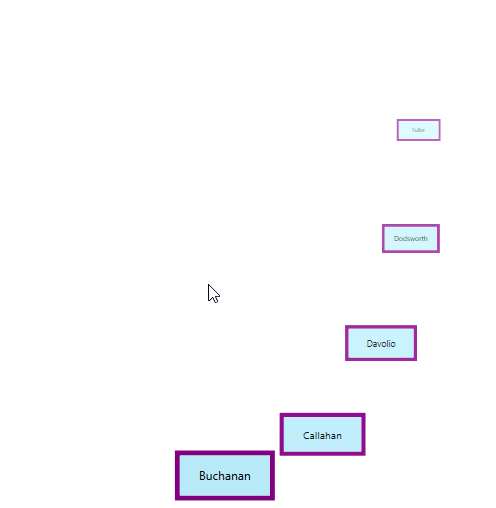
NOTE
Change custom view path
You can change the custom view path of the carousel items by using the Path property. The default value of Path property is null.
<syncfusion:Carousel VisualMode="CustomPath"
Name="carousel">
<syncfusion:Carousel.Path>
<Path Data="M0,100 L100,20"
Stroke="Blue"
StrokeThickness="2"
HorizontalAlignment="Stretch"
VerticalAlignment="Stretch"/>
</syncfusion:Carousel.Path>
</syncfusion:Carousel>carousel.VisualMode = VisualMode.CustomPath;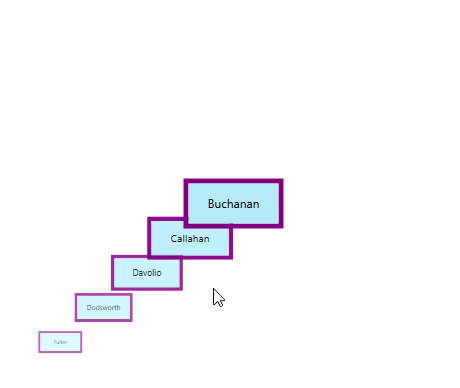
NOTE
Change display item count
You can change the number of carousel items displayed per page in the Carousel control by using the ItemsPerPage property. ItemsPerPage is effective only on VisualMode.CustomPath view mode. The default value of ItemsPerPage property is -1.
<syncfusion:Carousel ItemsPerPage="3"
VisualMode="CustomPath"
Name="carousel"/>carousel.ItemsPerPage = 3;
carousel.VisualMode = VisualMode.CustomPath;
NOTE
Select carousel item
You can select a carousel item by mouse click on the specific item. You can get the selected item and its value by using the SelectedItem and SelectedValue properties. You can also get the selected item index by using the SelectedIndex property. You can only select a single item at a time.
Select carousel item programmatically using property
You can select a particular carousel item programmatically by using the CarouselItem.IsSelected property.
<Window.Resources>
<Style x:Key="selecteditemStyle" TargetType="syncfusion:CarouselItem" >
<Style.Triggers>
<Trigger Property="IsSelected" Value="True">
<Setter Property="Foreground" Value="Red"/>
<Setter Property="FontWeight" Value="Bold"/>
</Trigger>
</Style.Triggers>
</Style>
</Window.Resources>
<Grid>
<syncfusion:Carousel ItemContainerStyle="{StaticResource selecteditemStyle}"
x:Name="carousel">
<syncfusion:CarouselItem Content="Item1"/>
<syncfusion:CarouselItem Content="Item2"/>
<syncfusion:CarouselItem Content="Item3" IsSelected="True"/>
<syncfusion:CarouselItem Content="Item4"/>
<syncfusion:CarouselItem Content="Item5"/>
</syncfusion:Carousel>
</Grid>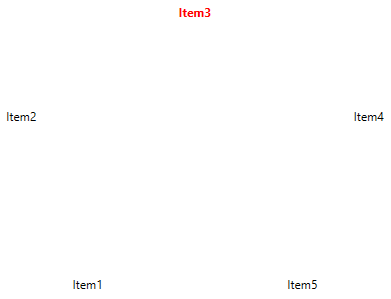
NOTE
Select carousel item programmatically using command and methods
You can select a previous, next, first or last carousel items programmatically by using the commands and methods.
-
SelectFirstItemCommand or SelectFirstItem() - To select the first item.
-
SelectLastItemCommand or SelectLastItem() - To select the last item.
-
SelectPreviousItemCommand or SelectPreviousItem - To select the previous item from the currently selected item.
-
SelectNextItemCommand or SelectNextItem() - To select the next item from the currently selected item.
-
SelectPreviousPageCommand or SelectPreviousPage() - To select the previous page item.
-
SelectNextPageCommand or SelectNextPage() - To select the next page item.
NOTE
Selected item changed notification
The selected item changed in Carousel can be examined using SelectionChanged event. The SelectionChanged event contains the old and newly selected item in the OldValue and NewValue properties.
<syncfusion:Carousel SelectionChanged="Carousel_SelectionChanged"
Name="carousel"/>Carousel carousel = new Carousel();
carousel.SelectionChanged += Carousel_SelectionChanged;You can handle the event as follows,
private void Carousel_SelectionChanged(DependencyObject d, DependencyPropertyChangedEventArgs e) {
//Get old and new selected carousel item
var oldValue = e.OldValue;
var newValue = e.NewValue;
}Change radius of carousel item
You can change the radius of the Carousel control by setting the value to the RadiusX and RadiusY properties. Based on the radius points, items are arranged. This will effective only on VisualMode.Standard view mode. The default value of RadiusX property is 250 and RadiusY property is 150.
<syncfusion:Carousel RadiusX="100"
RadiusY="100"
VisualMode="Standard"
Name="carousel"/>carousel.RadiusX = 100;
carousel.RadiusY = 100;
carousel.VisualMode = VisualMode.Standard;
NOTE
Setting the background
You can change the background color of Carousel by using the Background property. The default value of Background property is White.
<syncfusion:Carousel Background="Red"
Name="carousel"/>carousel.Background = Brushes.Red;
NOTE
Change flow direction
You can change the flow direction of the Carousel layout from right to left by setting the FlowDirection property value as RightToLeft. The default value of FlowDirection property is LeftToRight.
<syncfusion:Carousel FlowDirection="RightToLeft"
Name="carousel"/>Carousel carousel = new Carousel();
carousel.FlowDirection = FlowDirection.RightToLeft;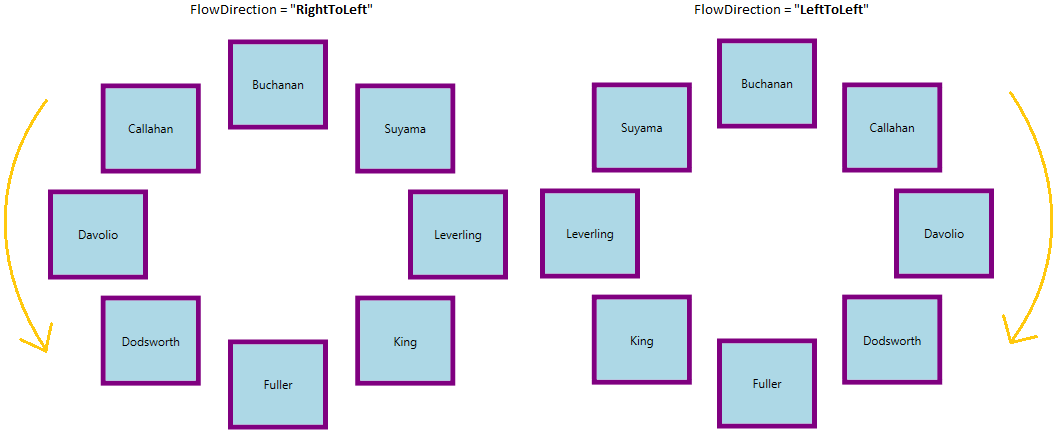
NOTE
Virtualization support
You can enable the UI virtualization support in Carousel, which allows the users to load large sets of data without affecting loading or scrolling performance by setting the EnableVirtualization property value as true. This feature allows users to reduce the loading time of Carousel items regardless of items count. The default value of EnableVirtualization property is false.
<syncfusion:Carousel EnableVirtualization="True"
Name="carousel"/>Carousel carousel = new Carousel();
carousel.EnableVirtualization = true;Custom UI for carousel item using template
You can customize the appearance of each carousel item by using the ItemTemplate property. If you want to change the appearance of particular carousel item appearance, use ItemTemplateSelector property. The DataContext of the ItemTemplate property is CarouselItem.
//Model.cs
public class CarouselModel {
public string Header { get; set; }
}
//ViewModel.cs
public class ViewModel {
private ObservableCollection<CarouselModel> collection;
public ObservableCollection<CarouselModel> HeaderCollection {
get {
return collection;
}
set {
collection = value;
}
}
public ViewModel() {
HeaderCollection = new ObservableCollection<CarouselModel>();
HeaderCollection.Add(new CarouselModel() { Header = "Buchanan" });
HeaderCollection.Add(new CarouselModel() { Header = "Callahan" });
HeaderCollection.Add(new CarouselModel() { Header = "Davolio" });
HeaderCollection.Add(new CarouselModel() { Header = "Dodsworth" });
HeaderCollection.Add(new CarouselModel() { Header = "Fuller" });
HeaderCollection.Add(new CarouselModel() { Header = "King" });
HeaderCollection.Add(new CarouselModel() { Header = "Leverling" });
HeaderCollection.Add(new CarouselModel() { Header = "Suyama" });
}
}<Window.DataContext>
<local:ViewModel/>
</Window.DataContext>
<Grid>
<syncfusion:Carousel ItemsSource="{Binding HeaderCollection}"
ScaleFraction="0.5"
Name="carousel" >
<syncfusion:Carousel.ItemTemplate>
<DataTemplate>
<Grid>
<Ellipse Width="200" Height="100"
Stroke="Green"
StrokeThickness="4"
Fill="Yellow"/>
<TextBlock HorizontalAlignment="Center"
VerticalAlignment="Center"
Text="{Binding Header}"/>
</Grid>
</DataTemplate>
</syncfusion:Carousel.ItemTemplate>
</syncfusion:Carousel>
</Grid>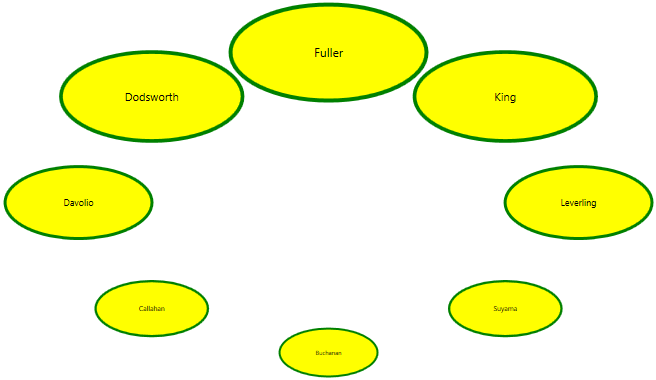
NOTE
Custom UI for carousel item using style
You can change the each carousel item appearance by using the ItemContainerStyle which is applied to the container element that generated for each carousel item. The default value of ItemContainerStyle is null. The DataContext of the ItemContainerStyle property is CarouselItem.
//Model.cs
public class CarouselModel {
public string Header { get; set; }
public ImageSource ImageSource { get; set; }
}
//ViewModel.cs
public class ViewModel {
private ObservableCollection<CarouselModel> persons;
public ObservableCollection<CarouselModel> Persons
{
get {
return persons;
}
set {
persons = value;
}
}
public ViewModel() {
Persons = new ObservableCollection<CarouselModel>();
Persons.Add(new CarouselModel() {
Header = "Buchanan",
ImageSource = new BitmapImage
(new Uri(@"/Images/Buchanan.png", UriKind.RelativeOrAbsolute))
});
Persons.Add(new CarouselModel() {
Header = "Callahan",
ImageSource = new BitmapImage
(new Uri(@"/Images/Callahan.png", UriKind.RelativeOrAbsolute))
});
Persons.Add(new CarouselModel() {
Header = "Davolio",
ImageSource = new BitmapImage
(new Uri(@"/Images/Davolio-1.png", UriKind.RelativeOrAbsolute))
});
Persons.Add(new CarouselModel() {
Header = "Dodsworth",
ImageSource = new BitmapImage
(new Uri(@"/Images/dodsworth.png", UriKind.RelativeOrAbsolute))
});
Persons.Add(new CarouselModel() {
Header = "Fuller",
ImageSource = new BitmapImage
(new Uri(@"/Images/Fuller.png", UriKind.RelativeOrAbsolute))
});
Persons.Add(new CarouselModel() {
Header = "King",
ImageSource = new BitmapImage
(new Uri(@"/Images/King.png", UriKind.RelativeOrAbsolute))
});
Persons.Add(new CarouselModel() {
Header = "Leverling",
ImageSource = new BitmapImage
(new Uri(@"/Images/Leverling.png", UriKind.RelativeOrAbsolute))
});
Persons.Add(new CarouselModel() {
Header = "Suyama",
ImageSource = new BitmapImage
(new Uri(@"/Images/Suyama.png", UriKind.RelativeOrAbsolute))
});
}
}<Window.DataContext>
<local:ViewModel/>
</Window.DataContext>
<Grid>
<syncfusion:Carousel ScaleFraction="0.5"
VisualMode="Standard"
Name="carousel"
ItemsSource="{Binding Persons}">
<syncfusion:Carousel.ItemContainerStyle>
<Style TargetType="syncfusion:CarouselItem">
<Setter Property="Template">
<Setter.Value>
<ControlTemplate TargetType="syncfusion:CarouselItem">
<Grid>
<Grid.RowDefinitions>
<RowDefinition/>
<RowDefinition/>
</Grid.RowDefinitions>
<Border x:Name="border">
<Grid>
<Ellipse Stroke="Red"
StrokeThickness="4"
Fill="Yellow"/>
<Border Margin="20">
<Grid>
<Grid.RowDefinitions>
<RowDefinition Height="*"/>
<RowDefinition Height="Auto"/>
</Grid.RowDefinitions>
<Viewbox Height="150" Width="150">
<Image Source="{Binding ImageSource}"/>
</Viewbox>
<TextBlock Text="{Binding Header}"
FontWeight="Bold"
Grid.Row="1"
HorizontalAlignment="Center" />
</Grid>
</Border>
</Grid>
</Border>
</Grid>
</ControlTemplate>
</Setter.Value>
</Setter>
</Style>
</syncfusion:Carousel.ItemContainerStyle>
</syncfusion:Carousel>
</Grid>
NOTE
Custom UI for specific carousel item using style selector
You can select a various custom appearance for the carousel items by using the ItemContainerStyleSelector property. The DataContext of the ItemContainerStyleSelector property is CarouselItem.
//Model.cs
public class CarouselModel {
public string Name { get; set; }
public int Age { get; set; }
}
//ViewModel.cs
public class ViewModel {
private ObservableCollection<CarouselModel> persons;
public ObservableCollection<CarouselModel> Persons {
get {
return persons;
}
set {
persons = value;
}
}
public ViewModel() {
Persons = new ObservableCollection<CarouselModel>();
Persons.Add(new CarouselModel() { Name = "Buchanan", Age = 40 });
Persons.Add(new CarouselModel() { Name = "Callahan", Age = 53 });
Persons.Add(new CarouselModel() { Name = "Davolio", Age = 42 });
Persons.Add(new CarouselModel() { Name = "Dodsworth", Age = 60 });
Persons.Add(new CarouselModel() { Name = "Fuller", Age = 46 });
Persons.Add(new CarouselModel() { Name = "King", Age = 65 });
Persons.Add(new CarouselModel() { Name = "Leverling", Age = 57 });
Persons.Add(new CarouselModel() { Name = "Suyama", Age = 30 });
}
}
// A class that choose style for for the items
public class PersonStyleSelector : StyleSelector {
public Style ElderStyle { get; set; }
public Style YoungerStyle { get; set; }
public override Style SelectStyle(object item, DependencyObject container) {
if ((item as CarouselModel).Age > 50)
return ElderStyle;
else
return YoungerStyle;
}
}<Window.Resources>
<Style TargetType="syncfusion:CarouselItem" x:Key="elderStyle">
<Setter Property="Template">
<Setter.Value>
<ControlTemplate>
<Grid>
<Ellipse Width="100" Height="50"
Stroke="Purple"
StrokeThickness="4"
Fill="LightBlue"/>
<TextBlock HorizontalAlignment="Center"
VerticalAlignment="Center"
Text="{Binding Name}"/>
</Grid>
</ControlTemplate>
</Setter.Value>
</Setter>
</Style>
<Style TargetType="syncfusion:CarouselItem" x:Key="youngerStyle">
<Setter Property="Template">
<Setter.Value>
<ControlTemplate>
<Border Height="50"
Width="100"
BorderBrush="Yellow"
BorderThickness="5"
Background="LightBlue">
<TextBlock HorizontalAlignment="Center"
VerticalAlignment="Center"
Text="{Binding Name}"/>
</Border>
</ControlTemplate>
</Setter.Value>
</Setter>
</Style>
<local:PersonStyleSelector x:Key="personStyleSelector"
ElderStyle="{StaticResource elderStyle}"
YoungerStyle="{StaticResource youngerStyle}"/>
</Window.Resources>
<Grid>
<syncfusion:Carousel ItemContainerStyleSelector="{StaticResource personStyleSelector}"
ItemsSource="{Binding Persons}"
DisplayMemberPath="Name"
ScaleFraction="0.5"
VisualMode="Standard"
Name="carousel" >
<syncfusion:Carousel.DataContext>
<local:ViewModel></local:ViewModel>
</syncfusion:Carousel.DataContext>
</syncfusion:Carousel>
</Grid>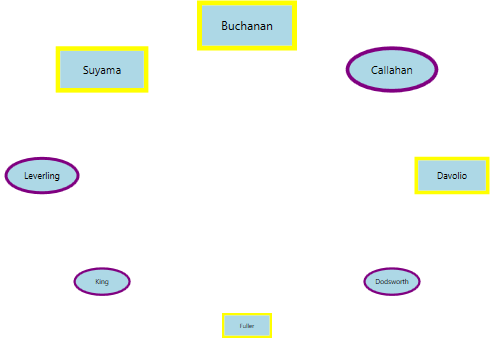
NOTE